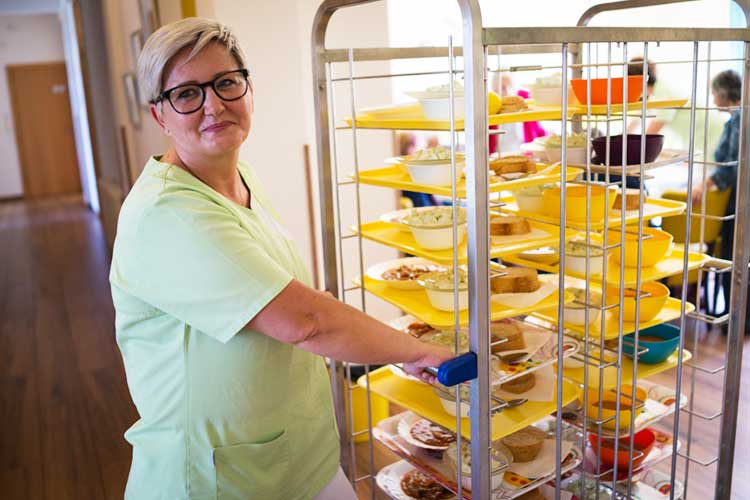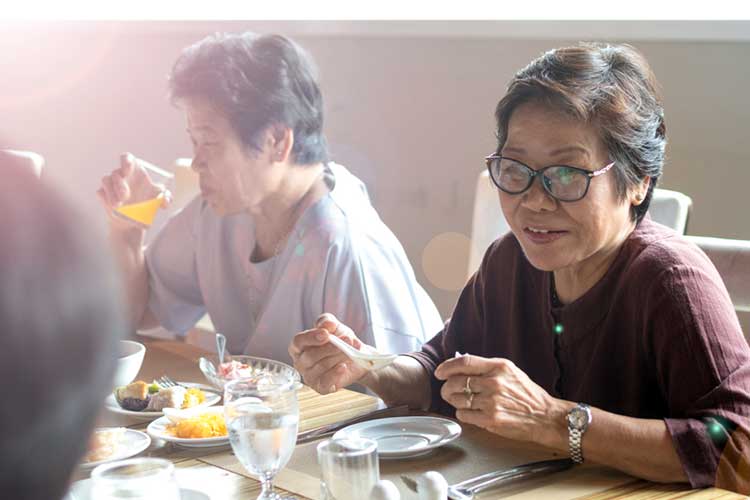Attentive meal service combined with healthy and flavoursome food can be a high point in the day for aged care residents.
Dining in aged care is a topic worthy of consideration, as about half of all aged care residents in Australia are either malnourished or at risk of malnutrition (Dietitians Australia 2023).
It would be unwise to underestimate the effect that food presentation and service have on appetite and an individual’s eagerness to participate in mealtime.
This article will provide tips for providing high-quality meal service in aged care facilities. See other Ausmed articles for information on food handling and meal assistance.
Meal Service Under the Strengthened Aged Care Quality Standards
Meal service and the dining experience are important considerations under Standard 6: Food and Nutrition of the strengthened Aged Care Quality Standards.
Outcome 6.1: Partnering with older people on food and nutrition requires aged care organisations to collaborate with older people to ensure that the dining experience is enjoyable. Providers should also continuously improve food service based on older people’s feedback (ACQSC 2024).
Outcome 6.2: Assessment of nutritional needs and preferences requires providers to consider each older person’s likes, dislikes, needs and preferences in relation to the dining experience (ACQSC 2024).
Outcome 6.3: Provision of food and drink expects that providers:
- Enable older people to decide what, when, where and how they consume meals
- Ensure food and drinks are appetising, tasty, served at an appropriate temperature and look visually appealing
- Provide older people with access to nutritious snacks, drinks and water at all times.
(ACQSC 2024)
Lastly, Outcome 6.4: Dining experience requires providers to:
- Establish a dining experience that promotes reablement, socialisation, belonging and enjoyment
- Enable older people to share meals with visitors.
(ACQSC 2024)

Meal Times
Always provide three main meals, as well as morning tea, afternoon tea and supper. These meals should be appropriately spaced out, however, it may be beneficial to allow residents flexibility (e.g. having a late breakfast if they wish to do so) (Bartl 2015).
Before Service
- Before the meal is served, it’s important to ensure everything is correctly set up and accessible for the resident. Tables should have appropriate tablecloths or mats, cloth napkins and/or clothing protectors.
- Sufficient staffing is integral to offering satisfactory meal service. It is difficult to anticipate how many residents will need help, and it is impossible to predict mealtime complications that could require immediate attention.
- To facilitate this, it may be worth holding two sittings for the midday meal. For example, the first sitting could be for residents requiring full assistance and the second sitting for residents requiring minimal assistance. Spread staff between these two sittings with a scheduled break in the middle.
(Bartl 2015)
Atmosphere
Ensure that the dining environment is welcoming, open and facilitates socialisation. It should be well-lit and pleasantly decorated.
Considerations should include:
- Room colour - pale walls are more calming
- Maintaining a comfortable, draught-free room temperature
- Background music, depending on residents’ preferences
- Preventing distractions such as loud music, televisions and unfamiliar people
- Ensuring chairs are comfortable, sturdy and well-balanced and have cushions or foam wedges available
- Cooking smells may stimulate appetite (however, keep in mind that cooking smells may put off some residents)
(Bartl 2015)
Using tablecloths, cloth napkins and small flower arrangements may make the dining environment feel more pleasant. Consider allowing residents to help set the table if they wish to do so (Bartl 2015).
It is important that tables and chairs are arranged so that residents, including those who use a wheelchair or another mobility aid, can move around freely (Bartl 2015).
Consider holding a ‘special service’ on occasion, for example, employing a chef to come to the facility to cook onsite. This means that at least once a month, the atmosphere, the type of meal and the meal service are novel for residents. Other ideas include themed days, barbecues and cupcake decorating. Eating outside from time to time may help to stimulate residents’ appetites (Bartl 2015).
Other ideas for optimising meal service include:
- Buffet-style service where residents can choose the amount and type of food they want to eat
- Taking around food platters containing vegetables, bread, cheese, biscuits, fruits etc.
- Providing condiment trolleys or trays
- Using name cards and menus
- Providing restaurant-style service with waiters.
(Bartl 2015)
Positive socialisation during mealtime has been found to increase appetite, as people generally eat more when in the company of others. Consider using tables that more easily facilitate conversation (e.g. round or square tables) and encourage interaction between residents (Bartl 2015).
Note that some residents may feel uncomfortable eating in a dining room with others and may find it an anxiety-provoking experience. Furthermore, some people are naturally less sociable than others and may prefer to eat some meals alone (Bartl 2015).
Mealtime should be relaxed and never rushed. This is particularly important for residents who may eat slowly but wish to remain independent. It is important to notice when an independent resident becomes tired or needs assistance to finish their meal (Cater Care 2018; Bartl 2015).
Furthermore, note that removing plates and serving the next course too quickly may be off-putting for residents who are still eating (Bartl 2015).

Attention to Detail
It’s crucial to serve food in a way that looks appealing and satisfying, and to arrange food with the same level of detail that you would serve your own meals.
It only takes a few small thoughtful additions to drastically improve the appearance of a meal. For example, adding herbs such as a sprig of parsley or basil will add colour to a dish. Offering condiment options is relatively easy to incorporate into meal service and may offer residents a sense of agency (Unilever Food Solutions 2020).
Presenting food in an appealing way can prove challenging when catering to residents who experience difficulty eating solid foods and require pureed or modified foods. Texture-modified foods can look unsightly, so it is important to pay extra attention to these meals and to come up with creative ways of presenting them.
While pureed food is a solution to choking hazards and caters to people with chewing and swallowing difficulties, it may be so unrecognisable from its original source that residents might refuse to eat it. A solution to this is to reshape the pureed food with a food mould, for example, a carrot-shaped mould for orange puree (Egan 2019).
Always ensure that you provide appropriate cutlery and eating utensils and serve food in a manageable form. This is particularly important for residents who may feel embarrassed about spilling or dribbling food in front of others (Bartl 2015).
Crockery plates and cups are generally better than plasticware, as they are more homely and less childlike (Bartl 2015).
There’s no need to go overboard but consider serving meals on colourful crockery and utensils. This will:
- Instantly liven up the meal
- Assist residents who are living with visual/cognitive impairment.
(Unilever Food Solutions 2020)
(Note: monochromatic cutlery and crockery are known to be confusing for people living with dementia.)
Cultural Considerations
Avoid a one-size-fits-all approach to food service.
Take the time to find out what the residents prefer. Beyond catering to their dietary restrictions or preferences, familiarise yourself with their cultural needs in regards to food preparation, for example, if a resident requires their meal to be kosher or halal certified.
Sharing food and coming together during mealtime is highly valued in certain cultures. Visiting family and friends should be encouraged to bring and share food, but they will need to be briefed on food safety guidelines (Cater Care 2018; Bartl 2015).

After Service
There’s a good chance residents will have feedback on the way meals are served and mealtime is carried out. It’s important to take this on board and ensure that this feedback is relayed to any others who may be involved in meal planning and preparation.
Take into consideration residents who may be reluctant to share their feedback openly and consider anonymous surveys or questionnaires (Cater Care 2018)
Malnutrition
Malnutrition is rife in Australian aged care facilities. Media reports have shone a light on the poor state of food in aged care facilities, leaving little doubt as to why residents might be reluctant to eat regular meals.
Malnutrition presents a major risk factor for sarcopenia and related issues such as an increased risk of falls, arthritis, depression, fractures, pressure injuries, poor quality of life and hospitalisation (DPS Media 2017; ProPortion Foods 2018).
Access to adequate food and nutrition in an enjoyable form is a fundamental right that should be observed for all residents of aged care facilities (ProPortion Foods 2018).
It is well understood that meal appearance, smell, flavour, and a relaxed eating environment all contribute to appetite stimulation. Consider, for example, the difference careful food presentation could make for a resident who is adjusting to a diet of only pureed food.
Conclusion
Meal service is a crucial component of high-quality care. Your manner of service could greatly influence a client’s enjoyment of mealtime and directly result in them receiving the nutrition they require to be healthy and happy.
Test Your Knowledge
Question 1 of 3
Why is food presentation important in aged care?
Topics
Further your knowledge
 Free
Free Free
Free
References
- Aged Care Quality and Safety Commission 2024, Standard 6: Food and Nutrition, Australian Government, viewed 24 June 2024, https://www.health.gov.au/resources/publications/strengthened-aged-care-quality-standards-august-2025?language=en/food-and-nutrition
- Bartl, R & Bunney, C 2015, Best Practice Food and Nutrition Manual for Aged Care Homes Edition 2.2, New South Wales Government, viewed 21 June 2024, https://www.cclhd.health.nsw.gov.au/wp-content/uploads/BestPracticeFoodandNutritionManualforAgedCare.pdf
- Blumer, C 2018, ‘Would You Eat This? The Real Food Inside Aged Care Facilities in Australia’, ABC Investigations, 17 September, viewed 21 June 2024, https://www.abc.net.au/news/2018-09-17/food-in-aged-care/10212880
- Cater Care 2018, Top 5 Tips to Improve the Nutritional Outcomes in Your Aged Care Facility, Cater Care, viewed 21 June 2024, https://www.catercare.com.au/top-5-tips-improve-nutritional-outcomes-aged-care-facility/
- Dietitians Australia 2023, Malnutrition, Dietitians Australia, viewed 21 June 2024, https://dietitiansaustralia.org.au/health-advice/malnutrition
- DPS Media 2017, ‘Older People at Disproportionate Risk of Malnutrition’, Aged Care Guide, 30 May, viewed 21 June 2024, https://www.agedcareguide.com.au/talking-aged-care/older-people-are-often-at-disproportionate-risk-of-malnutrition
- Egan, C 2019, ‘ ‘We Eat with Our Eyes’: Getting Food Right in Aged Care, HelloCare, 20 March, viewed 21 June 2024, https://hellocaremail.com.au/eat-eyes-getting-food-right-aged-care/
- ProPortion Foods 2018, Enhancing Nutrition and Flavour in Aged Care Food, ProPortion Foods, viewed 21 June 2024, http://www.proportionfoods.com.au/enhancing-nutrition-and-flavour-in-aged-care-food/
- Unilever Food Solutions 2020, Food Plating and Meal Presentation Tips for Aged Care, Unilever Food Solutions, viewed 21 June 2024, https://www.unileverfoodsolutions.com.au/chef-inspiration/aged-care-re-fresh/menu-planning-essentials/food-plating-and-meal-presentation-tips-for-aged-care.html
 New
New 
